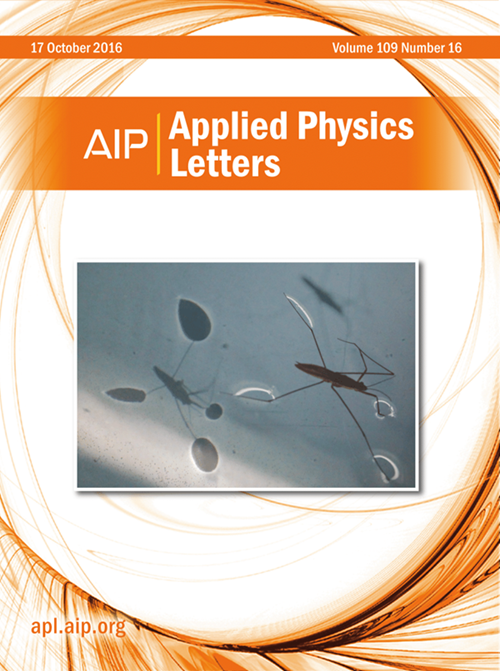(Bi1−xSbx)2Te3基异质结构中有效自旋-电荷转换增强太赫兹发射
IF 3.6
2区 物理与天体物理
Q2 PHYSICS, APPLIED
引用次数: 0
摘要
自旋电子学发射极中太赫兹辐射的增强对于实现太赫兹探测和成像具有极其重要的意义。基于三维拓扑绝缘体(TIs)的太赫兹发射极(Bi1-xSbx)2Te3 (BST)具有自旋动量锁定的狄拉克表面态,由于具有较高的自旋-电荷电流转换效率,有望表现出较强的太赫兹发射效率。在本研究中,通过调整Sb组成为0.95,将费米能级调整到Dirac点附近,(Bi0.05Sb0.95)2Te3/Co由于其独特的拓扑表面态而表现出更明显的太赫兹脉冲发射。通过优化BST和Co层的厚度,可以进一步增强太赫兹辐射。此外,通过在Co和BST之间插入Au层,由于Au膜与BST的拓扑表面态相互作用,形成了rashba介导的Dirac表面态,显著提高了发射效率,当Au厚度为2 nm时,发射效率达到了原始信号的127%。此外,在BST/Co/Ta异质结构中,由于逆Rashba-Edelstein效应和逆自旋霍尔效应的共同作用,THz发射强度进一步增强,达到BST/Co异质结构的143%。这些发现突出了ti基异质结构作为高性能、室温太赫兹源的潜力,在超快光谱、成像和下一代通信技术中具有广泛的应用。本文章由计算机程序翻译,如有差异,请以英文原文为准。
Enhanced terahertz emission by efficient spin-to-charge conversion in (Bi1−xSbx)2Te3 based heterostructures
The enhanced terahertz (THz) emission in the spintronics based emitter is of extreme significance for the realization of THz probing and imaging. The THz emitter based on three-dimensional topological insulators (TIs), (Bi1–xSbx)2Te3 (BST) with spin-momentum-locked Dirac surface states, is expected to exhibit strong THz emission efficiency due to the high spin-to-charge current conversion efficiency. In this study, by tuning the Fermi level close to the Dirac point through adjusting the Sb composition to 0.95, (Bi0.05Sb0.95)2Te3/Co exhibits more pronounced THz pulse emission due to the unique topological surface states. The THz emission could be further enhanced by optimizing the thickness of the BST and Co layers. In addition, by inserting an Au layer between Co and BST, a Rashba-mediated Dirac surface state is formed due to the interaction between the Au film and the topological surface states of BST, which significantly enhances the emission efficiency—reaching 127% of the original signal when the Au thickness is 2 nm. Furthermore, in the BST/Co/Ta heterostructure, THz emission is further boosted due to the combined contributions of the inverse Rashba–Edelstein effect and the inverse spin Hall effect, achieving an intensity of 143% of that in the BST/Co heterostructure. These findings highlight the potential of TI-based heterostructures as high-performance, room-temperature THz sources, with broad applications in ultrafast spectroscopy, imaging, and next-generation communication technologies.
求助全文
通过发布文献求助,成功后即可免费获取论文全文。
去求助
来源期刊

Applied Physics Letters
物理-物理:应用
CiteScore
6.40
自引率
10.00%
发文量
1821
审稿时长
1.6 months
期刊介绍:
Applied Physics Letters (APL) features concise, up-to-date reports on significant new findings in applied physics. Emphasizing rapid dissemination of key data and new physical insights, APL offers prompt publication of new experimental and theoretical papers reporting applications of physics phenomena to all branches of science, engineering, and modern technology.
In addition to regular articles, the journal also publishes invited Fast Track, Perspectives, and in-depth Editorials which report on cutting-edge areas in applied physics.
APL Perspectives are forward-looking invited letters which highlight recent developments or discoveries. Emphasis is placed on very recent developments, potentially disruptive technologies, open questions and possible solutions. They also include a mini-roadmap detailing where the community should direct efforts in order for the phenomena to be viable for application and the challenges associated with meeting that performance threshold. Perspectives are characterized by personal viewpoints and opinions of recognized experts in the field.
Fast Track articles are invited original research articles that report results that are particularly novel and important or provide a significant advancement in an emerging field. Because of the urgency and scientific importance of the work, the peer review process is accelerated. If, during the review process, it becomes apparent that the paper does not meet the Fast Track criterion, it is returned to a normal track.
 求助内容:
求助内容: 应助结果提醒方式:
应助结果提醒方式:


